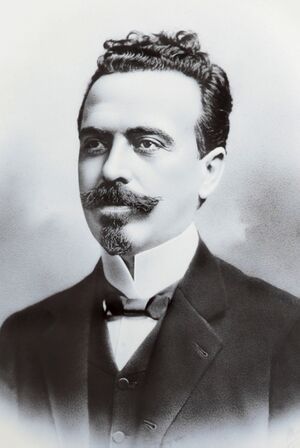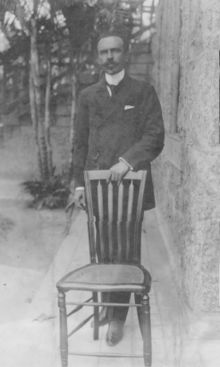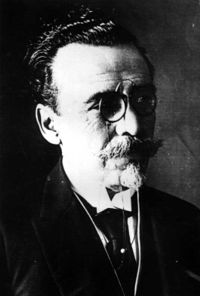نيلو پيسانيا Nilo Peçanha
| نيلو پيسانا Nilo Peçanha | |||
|---|---|---|---|

| |||
| رئيس البرازيل رقم 17 | |||
| في المنصب 14 يونيو 1909 – 15 نوفمبر 1910 | |||
| نائب الرئيس | لا يوجد | ||
| سبقه | أفونسو أوگوستو موريرا پـِنا | ||
| خلفه | إرمس رودريگز دا فونسكا | ||
| نائب رئيس البرازيل | |||
| في المنصب 15 November 1906 – 14 June 1909 | |||
| الرئيس | Afonso Pena | ||
| سبقه | أفونسو پينا | ||
| خلفه | Venceslau Brás | ||
| |||
| تفاصيل شخصية | |||
| وُلِد | 2 أكتوبر 1867 Campos, ريو ده جانيرو، البرازيل | ||
| توفي | 31 مارس 1924 (aged 56) ريو دي جانيرو، ريو دي جانيرو، البرازيل | ||
| القومية | برازيلي | ||
| الحزب | Rio Republican Party | ||
| الزوج | Anita de Castro Belisário de Sousa | ||
| الأنجال | 3 | ||
| الجامعة الأم | Faculty of Law of Recife | ||
| التوقيع | 
| ||
نيلو پيسانا Nilo Peçanha، (و. 2 أكتوبر 1867 - ت. 31 مارس 1924)، هو سياسي برازيلي . شغل منصب حاكم ولاية ريو ده جانيرو (1903-1906)، ثم انتخب نائبا لرئيس البرازيل في عام 1906. تولى الرئاسة في عام 1909 عقب وفاة الرئيس أفونسو أوگوستو موريرا پينا وخدم حتى عام 1910.[1]
في نهاية ولايته عام 1910، عاد إلى مجلس الشيوخ، وبعد عامين في 1912 انتخب مرة أخرى حاكما لولاية ريو دي جانيرو . تخلى عن هذا المنصب في عام 1917 ليتولي منصب وزير العلاقات الخارجية، وخلال فترة وزارته أعلنت البرازيل الحرب ضد دول المحور في الحرب العالمية الأولى في عام 1918، وانتخب بعدها مرة أخرى إلى مجلس الشيوخ. شارك لاحقا في الانتخابات الرئاسية لعام 1922 ولكنه هزم فيها. ليعتزل السياسة بعد ذلك .
توفي پيسانيا في عام 1924 بريو دي جانيرو.
سيرته
Nilo Peçanha was born to Sebastião de Sousa Peçanha, a baker, and Joaquina Anália de Sá Freire, the descendant of a wealthy and noble family from northern Rio de Janeiro Province. He was one of seven siblings (five boys and two girls). His family lived in a state of poverty in the remote and poor neighborhood of Morro do Coco, Campos dos Goytacazes, and moved to the downtown area when Peçanha started elementary education.
He was frequently described as being a mulatto[2][3][4][5] and often ridiculed in the press for his skin color.[6][7][8] During his youth, the local Campos dos Goytacazes social elite alluded to him as the "mestiço do Morro do Coco" (the half-breed from Morro do Coco district).[9] In 1921, when he ran for the Presidency of Republic, letters falsely attributed to the other candidate Artur Bernardes were published by the press and caused a political crisis because they insulted both the former president Marshal Hermes da Fonseca and also Peçanha, another former president, claiming he was a mulatto. Gilberto Freyre mentioned his "mulatismo" in Brazilian politics as the same that prevailed in Brazilian soccer.[10] According to some scholars, his presidential photographs were touched up to whiten his dark skin.[7][11][12]
Some scholars assert that, despite his tez escura (dark skin color), Nilo Peçanha always hid his black origins, and to this day his descendants and family have denied that he was a mulatto.[13] The official biography written by a relative Celso Peçanha[14] does not mention his racial origins, but another later biography[2] does so, thus some scholars express doubts.[15] In any case, his origins were very humble: he used to claim that he had been raised on day-old bread and paçoca (a candy made with peanuts, cassava flour and sugar).[9]
After finishing his primary studies in his home city, Peçanha went on to study at the Law Schools of São Paulo and Recife, where he earned his degree. As a student, he supported both the campaign to abolish slavery and the establishment of the Republic.[بحاجة لمصدر]
Peçanha was married to Ana de Castro Belisário Soares de Sousa, also known as "Anita", the descendant of an aristocratic and wealthy family from his birth city. She was a daughter of lawyer João Belisário Soares de Souza and of Ana Rachel Ribeiro de Castro, who was herself a daughter of the Viscount of Santa Rita, one of the richest men in northern Rio de Janeiro State. The marriage was a social scandal since the bride escaped her house to marry her poor and "mulatto" groom, despite his status as a promising young politician.[9]
He worked as a lawyer and a university teacher in the Faculdade Livre de Direito do Rio de Janeiro.[بحاجة لمصدر]
Peçanha started his formal political career as an elected member of the first Republican Constituent Assembly in 1890. His political career advanced rapidly as a protégé of Campos Sales, who became President in 1898.[2] In 1903 he was successively elected Senator and then President (Governor) of the state of Rio de Janeiro, remaining in the latter position until 1906, when he was elected vice-president under President Afonso Pena.[بحاجة لمصدر] As Vice President, he also served as the President of the Senate.[16]
Pena died in 1909 while still in office and Peçanha assumed the presidency promising a government of Paz e Amor (Peace and Love). He was 41 years old, the youngest Brazilian president up until then.[17]
His presidential government had many political troubles and Nilo Peçanha proved himself a man of wit and courage. The balance of power of the Brazilian República Velha (Old Republic) was a compromise of the governing elites of the states of Minas Gerais and São Paulo. The deceased president, Afonso Pena, was elected with the support of this political alliance, but Peçanha assumed the presidency through being his vice-president and friction between the state oligarchies intensified. His government was also marked by friction with José Gomes Pinheiro Machado, the most powerful political leader of the Conservative Republican Party. Rui Barbosa started a run for the presidency promoting the "Campanha Civilista" (civilist campaign) against the Marshal Hermes da Fonseca, and attracted the opposition and discontent of the military. Federal intervention was required in the government of the Rio de Janeiro and Amazonas states.[17]
Peçanha was a man of sharp political wit who carved a practical and non-doctrinaire course between the positivists and the idealistic adherents of a pure Republican system that fought each other during the first decades of Brazilian Republic.[2] He was renowned for anticipating all the movements of his adversaries and achieving good political outcomes even when the odds were not favorable.[17]
During his presidency, Peçanha created the Ministry of Agriculture, Commerce and Industry, as well as the Indian Protection Service (SPI) and inaugurated the first system of technical schools in Brazil. He also began a basic sanitation program in the Baixada Fluminense region. He fought the excesses of workers in the public service and the high government expenditures that caused the elevation of taxes.[17]
At the end of his mandate, he returned to the Senate and two years later was again elected President (Governor) for the state of Rio de Janeiro. He gave up this post in 1917 to take up the position of Minister of Foreign Relations and during his rule Brazil declared war against the Central Powers in World War I. In 1918, he was again elected to the Senate.
In 1921 he was a leader of the Republican Reaction Movement which had the goal of championing the politics of liberalism against those of the state oligarchies. His run for the presidency was supported by the state governments of Rio Grande do Sul, Rio de Janeiro and Pernambuco, and also by a large part of the military. The campaign was fierce with mutual attacks and the famous case of letters falsely attributed to candidate Artur Bernardes which insulted the military and the former president Marshal Hermes da Fonseca. Brazil was divided and despite the strong support, Peçanha was defeated by Artur Bernardes, the pro-government candidate in the presidential election of 1922.
Peçanha died in 1924 in Rio de Janeiro, Federal District, retired from political life. His nephew, Celso Peçanha, later served as the acting Governor of Rio de Janeiro from 1961 to 1962.[18]
الورزاء
- وزير العدل: Esmeraldino Olímpio Torres Bandeira
- وزير البحرية: Rear Admiral Alexandrino Faria de Alencar
- وزير الحرب: الأول: General Carlos Eugênio de Andrade Guimarães; 2nd: General José Bernardino Bormann
- وزير العلاقات الخارجية: José Maria da Silva Paranhos Júnior، Barão do Rio Branco
- وزير المالية: José Leopoldo de Bulhões Jardim
- وزير الصناعة والنقل والأشغال العامة: الأول: Miguel Calmon du Pin e Almeida; الثاني: Francisco Sá
- وزير الزراعة والصناعة والتجارة: الأول: Antônio Cândido Rodrigues; الثاني: Francisco Sá – intern; 3rd: Rodolfo Nogueira da Rocha Miranda
انظر أيضا
المصادر
- ^ "نيلو بيسانا". ويكيبيديا.
- ^ أ ب ت ث خطأ استشهاد: وسم
<ref>غير صحيح؛ لا نص تم توفيره للمراجع المسماةgiffin - ^ خطأ استشهاد: وسم
<ref>غير صحيح؛ لا نص تم توفيره للمراجع المسماةaçucareira - ^ خطأ استشهاد: وسم
<ref>غير صحيح؛ لا نص تم توفيره للمراجع المسماةHerançadaEscravidão - ^ خطأ استشهاد: وسم
<ref>غير صحيح؛ لا نص تم توفيره للمراجع المسماةpaixão - ^ Beattie, Peter M. (2001-09-26). "Notes". The Tribute of Blood: Army, Honor, Race, and Nation in Brazil, 1864–1945. Latin America Otherwise (in الإنجليزية). Duke University Press. p. 298. ISBN 9780822327431. ISSN 2691-6282. Archived from the original on 2024-08-21. Retrieved 2008-09-03 – via Google Books.
[...] President Nilo Peçonha's African heritage was often parodied in political cartoons. [...]
- ^ أ ب خطأ استشهاد: وسم
<ref>غير صحيح؛ لا نص تم توفيره للمراجع المسماةlustosa - ^ خطأ استشهاد: وسم
<ref>غير صحيح؛ لا نص تم توفيره للمراجع المسماةcarneiro - ^ أ ب ت خطأ استشهاد: وسم
<ref>غير صحيح؛ لا نص تم توفيره للمراجع المسماةGrandesDamas - ^ خطأ استشهاد: وسم
<ref>غير صحيح؛ لا نص تم توفيره للمراجع المسماةfreire - ^ Dagoberto José Fonseca, anthropology professor of Universidade Estadual Paulista (UNESP) of Araraquara. In: Painéis resgatam negros ilustres, 'branqueados' pela história Archived 14 يونيو 2007 at the Wayback Machine (visited 3 September 2008)
- ^ Muniz Sodré, journalist, writer and professor of Universidade Federal do Rio de Janeiro (UFRJ). In: Fabio Gomes. Muniz Sodré e a Cultura do Sentir. Brasileirinho, a sua página de Música Brasileira Archived 24 ديسمبر 2007 at the Wayback Machine (visited 3 September 2008)
- ^ NASCIMENTO, Abdias; NASCIMENTO, Elisa Larkin. O negro e o Congresso brasileiro. In: MUNANGA, Kabengele. (Org.) História do negro no Brasil. v.1 Brasília:Fundação Palmares, 2004 apud DUARTE, Rebeca Oliveira. Nos Alicerces do Mundo: O dilema e a dialética na afirmação da identidade negra. Dissertação de Mestrado em Ciência Política. Recife: Universidade Federal de Pernambuco, agosto de 2006; pág. 25[dead link], and also apud Relatório de Desenvolvimento Humano – Racismo, Pobreza e Violência – Brasil 2005. Brasília: PNUD Brasil, pág. 28 (visited 3 September 2008)
- ^ خطأ استشهاد: وسم
<ref>غير صحيح؛ لا نص تم توفيره للمراجع المسماةneto - ^ Metráux, Alfred. "Brazil: Land of Harmony For all Races?" (PDF). UNESCO Courier. p. 3. Archived from the original on 2020-09-22. Retrieved 2008-09-03.
When [Henry Koster, an English traveller in the 19th century] asked one of his friends whether a certain Capitão-mor [...] was a mulatto or not, he received the following reply: 'He was a mulatto once. But now he is not.'
- ^ "República Velha (1889–1930) - Senado Federal". www25.senado.leg.br.
- ^ أ ب ت ث Galeria de Presidentes do Período da República Velha (1889–1930) (visited 4 September 2008)
- ^ Neto, Arnaldo (14 July 2016). "Morre o ex-governador campista Celso Peçanha". Folha da Manhã. Retrieved 7 August 2016.
قائمة المراجع
- KOIFMAN, Fábio, Organizador - Presidentes do Brasil, Editora Rio, 2001.
- PEÇANHA, Celso, Nilo Peçanha e a Revolução Brasileira, Editora Civilização Brasileira, 1969.
- SILVA, Hélio, Nilo Peçanha – 7º Presidente do Brasil, Editora Três, 1983.
- SANTIAGO, Sindulfo, Nilo Peçanha, uma Época Política, Editora Sete, 1962.
- TINOCO, Brígido, A Vida de Nilo Peçanha, Editora Jose Olympio, 1962.
روابط خارجية
| Nilo Peçanha
]].- O governo Nilo Peçanha no sítio oficial da Presidência da República do Brasil
- Mensagem ao Congresso Nacional em 1910
| مناصب سياسية | ||
|---|---|---|
| سبقه Quintino Antônio Ferreira de Sousa |
رئيس ريو ده جانيرو 1903–1906 |
تبعه Francisco Chaves de Oliveira Botelho |
| سبقه أفونسو أوگوستو موريرا پـِنا |
نائب رئيس البرازيل 1906–1909 |
تبعه إرمس رودريگز دا فونسكا |
| رئيس البرازيل 1909–1910 |
شاغر اللقب حمله بعد ذلك ڤنسيزلاو براس
| |
- Articles with dead external links from April 2020
- Short description is different from Wikidata
- Articles with unsourced statements from June 2015
- برازيليو القرن 19
- مواليد 1867
- وفيات 1924
- رؤساء البرازيل
- نواب رؤساء البرازيل
- رؤساء مجلس الشيوخ البرازيلي
- Federal University of Pernambuco alumni
- برازيليون من أصل پرتغالي
- حكام ريو دي جانيرو (ولاية)
- People from Campos dos Goytacazes
- Presidents of Brazil
- Presidents of the Federal Senate (Brazil)
- University of São Paulo alumni
- Vice presidents of Brazil
- Candidates for Vice President of Brazil




